Hauntings and possessions are distinct phenomena. Hauntings typically involve emotional connections to locations and can be residual or intelligent, with spirits replaying events or interacting with the living. Possessions, on the other hand, occur when a spirit takes control of a person, leading to drastic behavior changes. Both can create deep emotional impacts. Understanding these differences is essential. If you want to uncover more about their characteristics and implications, just keep exploring.
Key Takeaways
- Hauntings involve emotional connections to locations, while possessions occur when a spirit takes control of a person’s body.
- Hauntings can be residual (non-interactive) or intelligent (interactive), whereas possessions result in drastic behavioral changes.
- Emotional responses to hauntings vary, while possessions often lead to feelings of isolation and loss of self.
- Communication with spirits during hauntings may use methods like EVP or Ouija boards, while possessions typically require urgent intervention for healing.
- Cultural beliefs significantly influence interpretations of both hauntings and possessions, shaping societal fears and practices.
Defining Hauntings and Possessions
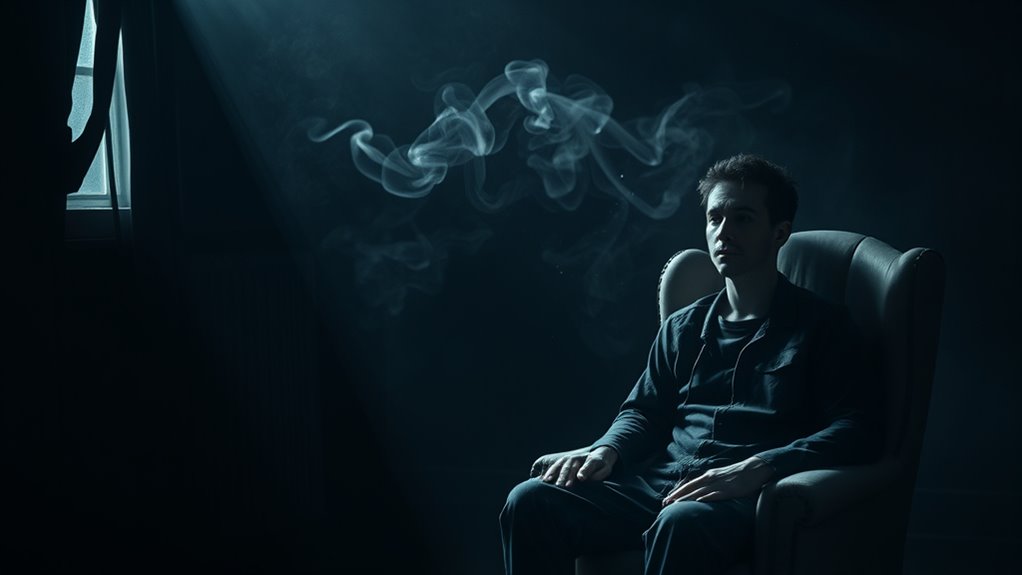
When you explore the domains of the supernatural, understanding the difference between hauntings and possessions is essential.
Hauntings typically involve emotional connections tied to locations or unresolved issues from the past. They can be categorized as either residual—where repeated actions occur without interaction—or intelligent, where spirits communicate with the living.
On the other hand, possessions happen when a spirit or entity takes control of a person’s body, leading to drastic changes in behavior and a loss of free will. Unlike hauntings, possessions often deal with manipulative entities, sometimes deemed demonic.
Recognizing these distinctions helps you address and manage experiences effectively, as the approaches for resolving hauntings and possessions vary greatly.
Common Characteristics of Hauntings
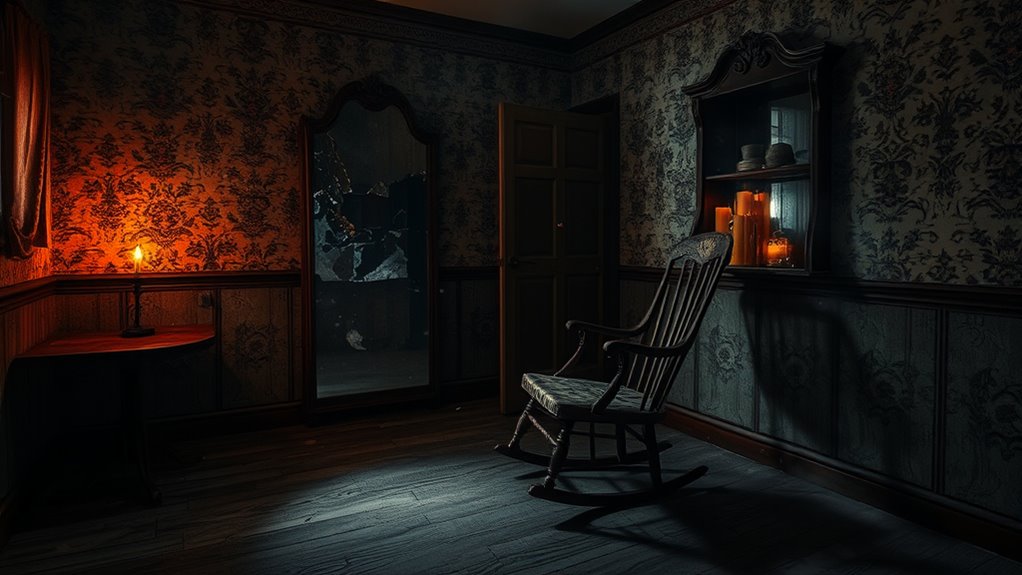
When you’re exploring hauntings, it’s important to recognize the differences between intelligent and residual types.
You’ll notice that emotional responses can vary greatly, influencing how people experience these phenomena.
Plus, timing often plays a significant role in ghost activity, adding another layer to your understanding of these encounters.
Intelligent vs. Residual Hauntings
Understanding the differences between intelligent and residual hauntings can enhance your perspective on ghostly encounters.
Intelligent hauntings involve spirits that actively communicate, often tied to unresolved emotional issues from their past lives. You might hear ghost stories about these spirits offering insights or messages, creating a connection with the living.
In contrast, residual hauntings are like a looped recording of past events, showcasing repetitive phenomena without any interaction. These hauntings usually occur in locations filled with emotional energy tied to traumatic events, where the spirit remains unaware.
Emotional Responses to Hauntings
Hauntings can stir a whirlwind of emotions, leaving you to grapple with feelings that range from fear to comfort. Encountering ghosts can evoke anxiety and trepidation, especially during intelligent hauntings where spirits interact, revealing personal histories and unresolved issues.
In contrast, residual hauntings often replay moments tied to emotional energy, prompting nostalgia or melancholy. These emotional responses are subjective; your beliefs and cultural background shape how you perceive these experiences.
You might find comfort in the presence of a spirit with unfinished business, feeling a connection to its lingering emotional energy. Ultimately, the impact of hauntings on your emotions varies widely, adding depth to your encounters with the supernatural.
Timing and Ghost Activity
The time of day plays a significant role in ghost activity, with many encounters reported during the night. Ghost hunters often prefer nighttime investigations to minimize electronic disturbances, enhancing the chances of encountering spirits.
While ghosts can manifest at any time, daylight might interfere with their presence. Residual hauntings typically showcase spirits replaying significant events, completely unaware of their surroundings.
On the other hand, intelligent hauntings involve ghosts that interact with the living, often tied to unresolved emotional issues.
Additionally, poltergeist activity tends to emerge with loud noises, escalating into more intense disturbances linked to the emotional energy within a household, especially from teenagers.
Understanding the timing of these manifestations can deepen your appreciation for the paranormal.
Common Characteristics of Possessions
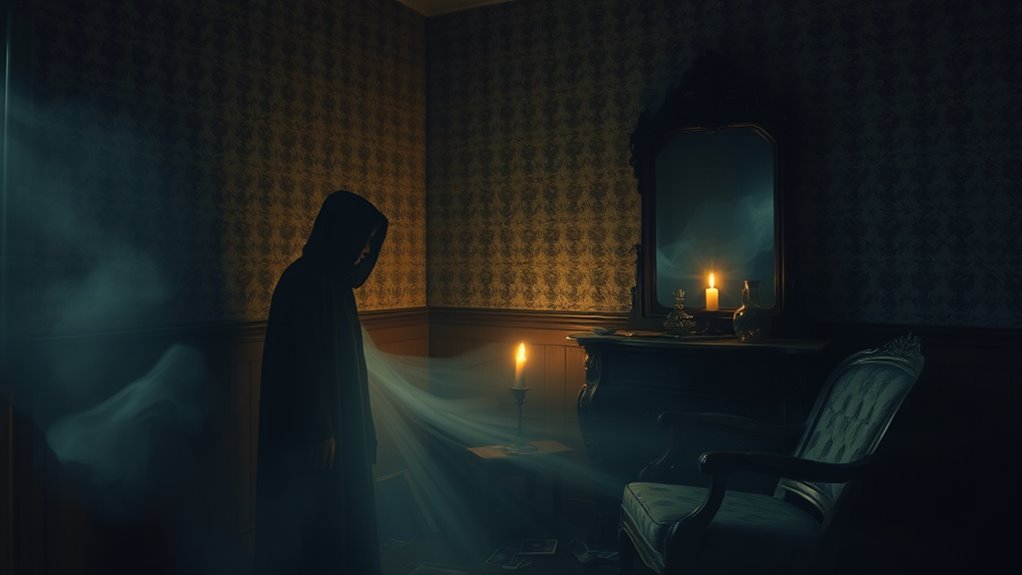
While you might think of possession as merely a dramatic trope in movies, it often involves unmistakable signs and symptoms that can drastically alter an individual’s behavior.
Possessions typically include a loss of control, with individuals exhibiting behaviors and speech that aren’t characteristic of their normal selves. You might notice unusual traits, like speaking in unknown languages or displaying superhuman strength.
Possessions reveal a chilling loss of control, manifesting in strange speech and extraordinary feats beyond one’s usual self.
Often, those possessed show aversion to sacred objects and can become aggressive towards those trying to help. Profound personality changes occur, particularly after a traumatic event.
Physical manifestations, such as strange contortions and unexplained wounds, can also arise. These possessions are usually linked to supernatural beings that aim to dominate the host for malevolent purposes.
Types of Spirits Involved in Hauntings
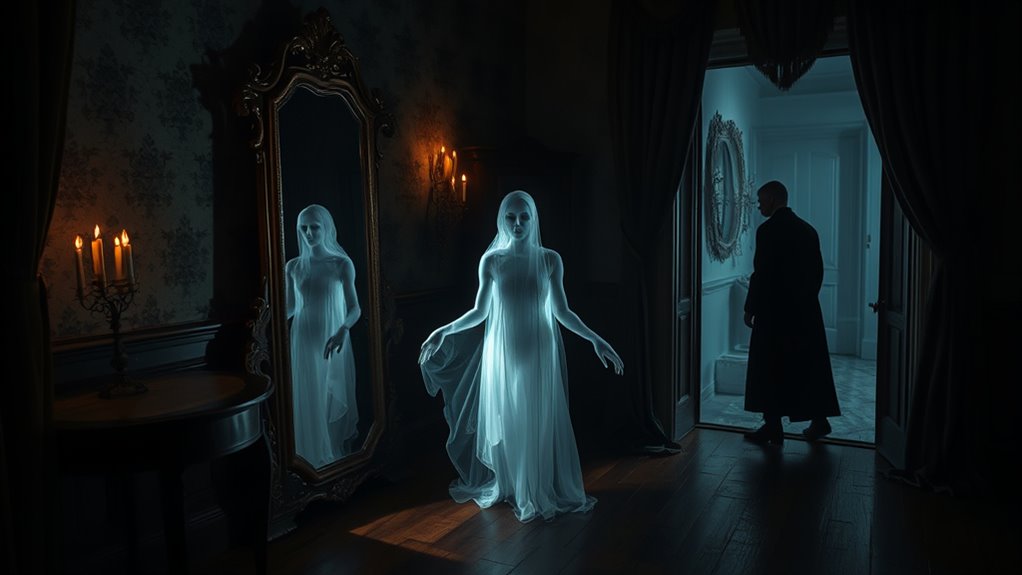
Possessions often involve intense confrontations with malevolent forces, but hauntings introduce a different spectrum of spiritual encounters.
You’ll encounter various types of spirits. For instance, residual hauntings replay past traumatic events, leaving the entities unaware of your presence. Intelligent hauntings, on the other hand, allow spirits to interact directly with you.
In poltergeist cases, disruptive noises and movements often relate to emotional turmoil, especially in adolescents, usually stopping when they leave the home.
You might also experience shadow people, shapeless dark figures that evoke dread, often seen in your peripheral vision.
Finally, portal hauntings are theorized doorways to other dimensions, adding an intriguing layer to the belief that ghosts are real.
Each type offers a unique glimpse into the paranormal.
Types of Entities Involved in Possessions

When it comes to possession, entities involved are often demonic in nature, lacking any human form and frequently described as horrific or shadowy figures.
Unlike ghosts, which exist with emotional ties to the living, these supernatural beings aim to manipulate and control you, breaking down your free will.
Demonic activity can manifest through physical attacks like shoving and scratching, often accompanied by foul odors like sulfur.
Demonic forces can inflict physical harm, such as shoving and scratching, often marked by the stench of sulfur.
You might also encounter spirits that possess individuals, retaining emotional connections tied to unresolved issues from life.
Additionally, shadow people can invoke dread, exhibiting threatening behavior.
These varied entities highlight the complex nature of possession phenomena, showing that not all entities are the same when it comes to influence and intent.
Emotional Impact of Hauntings
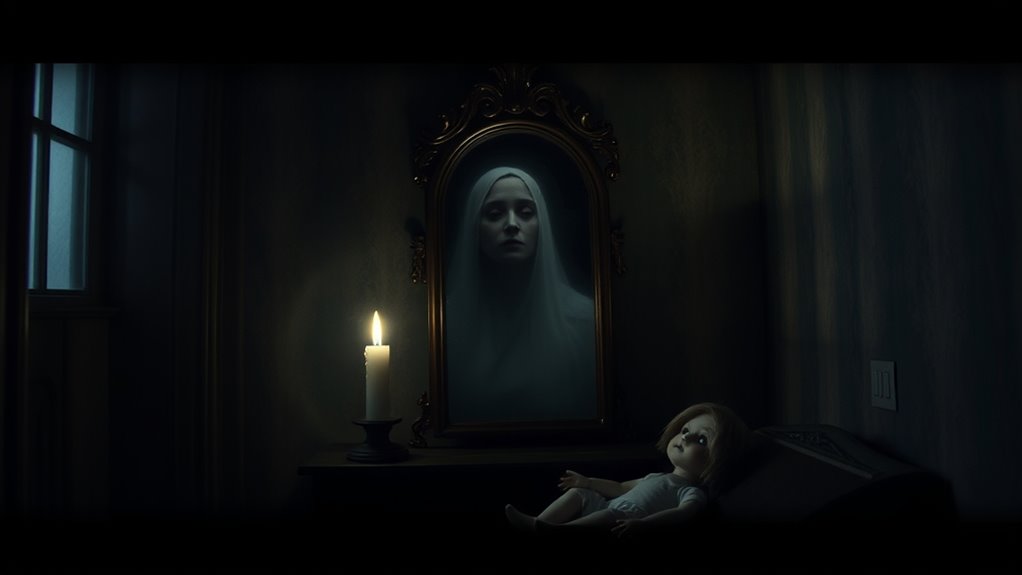
Although many people may not expect it, encounters with ghosts can stir deep emotional reactions, ranging from fear and anxiety to feelings of comfort and connection. The emotional impact of hauntings varies widely, influenced by personal beliefs and past experiences.
| Emotion | Encounter Type | Cultural Influence |
|---|---|---|
| Fear | Uneasy hauntings | Negative perceptions |
| Anxiety | Sudden ghost sightings | Superstitions |
| Comfort | Familiar spirit presence | Embraced heritage |
| Closure | Messages from the past | Spiritual beliefs |
While some individuals report dread, others find solace in the presence of ghosts. Ultimately, these emotional responses shape how you perceive hauntings, making each experience uniquely personal.
Emotional Impact of Possessions

While hauntings can evoke a mix of emotions, possessions often plunge individuals into a deeper turmoil. The emotional disturbances associated with possession can severely affect your mental health.
Here are some key impacts:
- Intense fear and anxiety
- Erratic behavior and mood swings
- Feelings of isolation from loved ones
- Physical symptoms like headaches and fatigue
- A longing for freedom from the entity
These intense experiences can leave you feeling disconnected from your true self, as the struggle between your personality and the possessing entity unfolds.
The dread and despair you might feel can create an urgent need for intervention, making it essential to address the emotional and psychological toll of possession.
The emotional and psychological toll of possession demands urgent intervention for healing and reclaiming your sense of self.
Seeking help is imperative for regaining control and improving mental health.
Methods of Communication With Spirits

Communicating with spirits can be a fascinating yet eerie experience, and various methods exist to bridge the gap between the living and the deceased. Mediums often serve as intermediaries, using techniques like EVP (Electronic Voice Phenomena) recording to capture potential spirit voices during ghost hunts.
Ouija boards are popular tools for spirit communication, allowing you to ask questions and receive responses through the movement of a planchette. Automatic writing is another intriguing method, where spirits guide a medium’s hand to write messages.
Additionally, some ghost hunters use pendulums or dowsing rods to detect spirit presence and get answers to yes or no questions. Each method offers a unique way to communicate with spirits and uncover their messages.
Safety Measures During Haunting Investigations
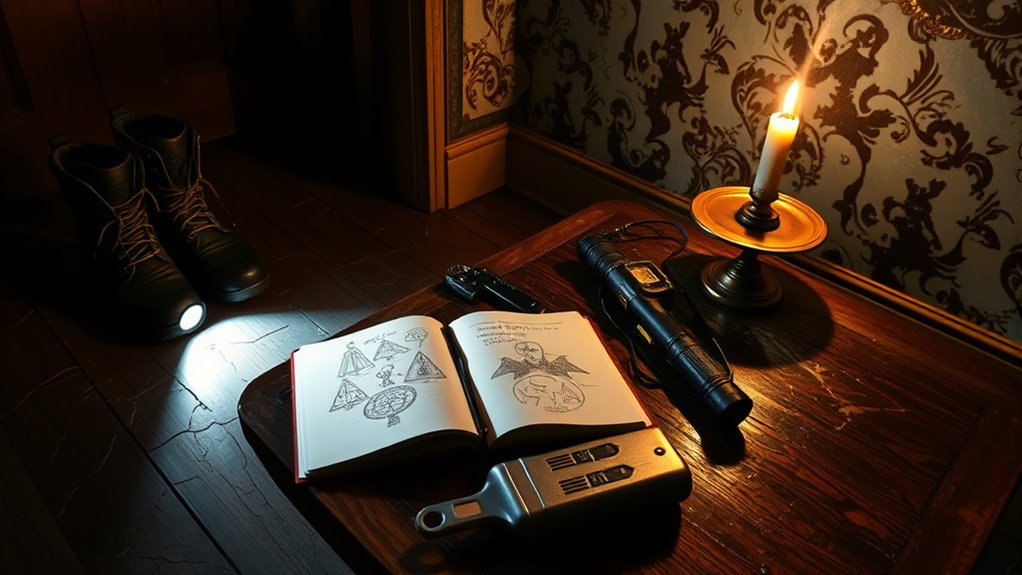
When commencing a haunting investigation, it’s essential to prioritize safety to guarantee a successful and secure experience. Here are some key measures to keep in mind:
- Conduct thorough research on the location’s history and previous encounters.
- Equip yourself with essential ghost hunting tools like digital thermometers and EMF meters.
- Establish a clear safety plan with designated roles and emergency contact procedures.
- Maintain a respectful attitude towards spirits to avoid negative interactions.
- Be aware of your emotional state and have grounding techniques in place.
Cultural Perspectives on Hauntings and Possessions
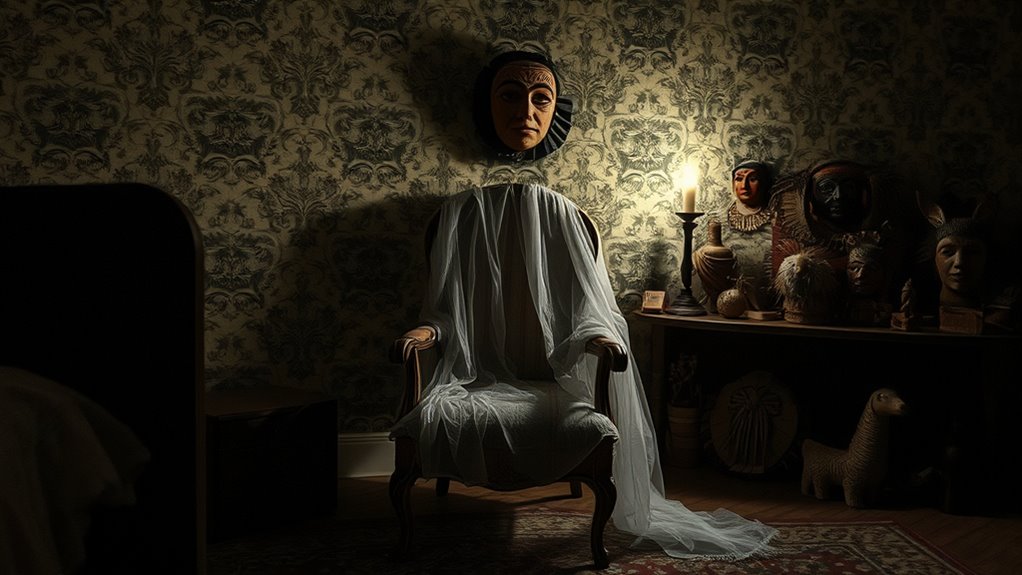
Cultural perspectives on hauntings and possessions reveal a rich tapestry of beliefs shaped by history and societal values. Different cultures interpret hauntings variably; in Mexico, the Day of the Dead celebrates deceased spirits, viewing them as family, while others fear spirits as ominous signs.
The Irish banshee highlights how hauntings can symbolize deeper societal fears, linking ghostly apparitions to impending death. Many cultures have rituals to manage these experiences, using cleansings in Indigenous practices to appease spirits or address possessions.
Historical accounts show that narratives of possession often reflect societal anxieties, like the Victorian era’s surge in possession stories tied to fears of the unknown. Understanding these cultural perspectives enriches your grasp of the supernatural.
Frequently Asked Questions
What Are Some Fun Facts About Ghosts?
Did you know that ghosts are part of cultures worldwide? You might be surprised to learn that around 40% of people under 55 in the UK believe in them!
The first documented ghost story dates back to 1500 B.C.E. in Babylon. Plus, poltergeists, known as “noisy spirits,” often appear around teens experiencing emotional turmoil.
And if you’re into history, famous ghosts like Anne Boleyn attract many enthusiasts to haunted sites across the UK!
What Causes Hauntings?
What if the walls around you could speak?
Hauntings often arise from residual energy imprints left behind by intense emotions or traumatic events. You may encounter intelligent hauntings, where spirits seek acknowledgment for unresolved issues.
Poltergeist activity typically reflects the emotional turmoil of living individuals, especially teens.
Environmental factors, like electromagnetic fields or sudden temperature changes, can also play a role in how these paranormal experiences manifest, influencing your perception of the supernatural.
Is There Any Evidence of Paranormal Activity?
You might wonder if there’s any evidence of paranormal activity, but scientific investigations haven’t found verifiable proof.
Many experiences, like electronic voice phenomena, often turn out to be random noise rather than ghostly messages. Additionally, supposed ghost photos and videos frequently result from misinterpretations or outright fabrications.
While nearly one in five people claim to have encountered ghosts, critical thinkers are less likely to believe, so skepticism is essential when evaluating these experiences.
Did People Think Paranormal Activity Was Real?
Oh sure, people totally thought paranormal activity was real! Throughout history, folks have spun tales of ghosts and ghouls, believing every creak in the night was a spectral visitor.
You can’t walk through ancient history without tripping over a ghost story or two! Even now, you’ll find many convinced they’ve seen the other side.
Conclusion
So, whether you’re dodging a ghostly apparition or trying to evict an unwelcome spirit from your friend, remember: hauntings are just misunderstood entities looking for attention, while possessions are like that annoying roommate who won’t leave. Embrace the chaos, keep some sage handy, and maybe invest in an exorcist—just in case. After all, who doesn’t love a little supernatural drama in their life? Happy haunting, and may your ghostly encounters be more entertaining than terrifying!









